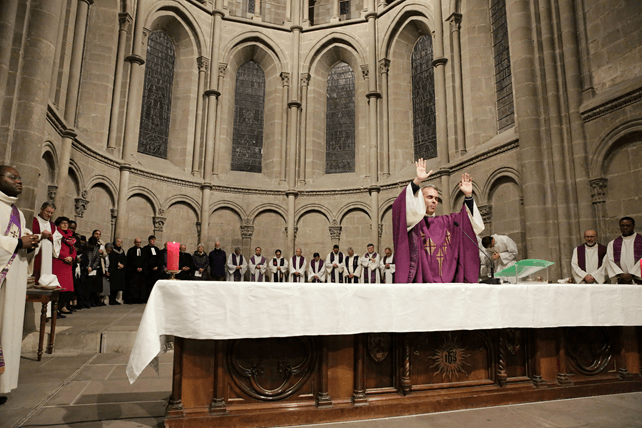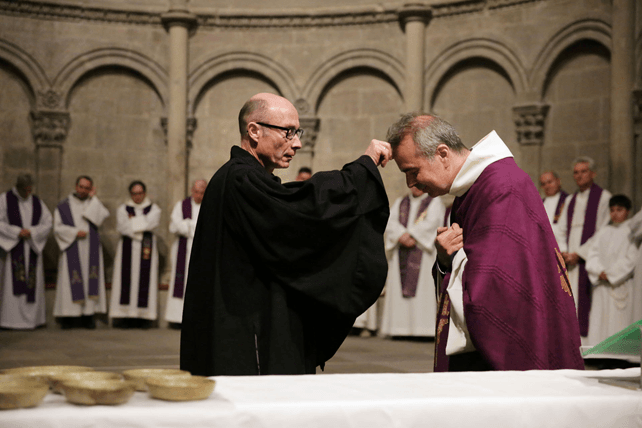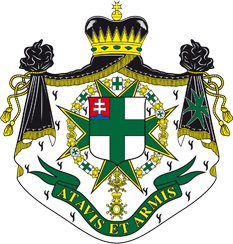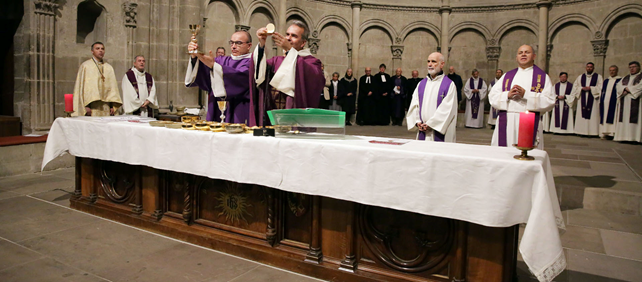Prvá katolícka omša od roku 1535 slávená v Ženevskej katedrále.
CELEBRATA PRESSO LA CATTEDRALE DI GINEVRA LA PRIMA MESSA CATTOLICA DAL 1535
La prima messa cattolica in quasi 500 anni è stata celebrata nella cattedrale di Ginevra, Svizzera, per la vigilia della prima domenica di Quaresima.
L’ultima messa celebrata nella cattedrale di St. Pierre ebbe luogo nel 1535. Dopo la Riforma, l’edificio fu occupato dalla Chiesa protestante riformata di Giovanni Calvino, che distrusse le statue e i dipinti della cattedrale e vietò il culto cattolico.
Circa 1.500 persone hanno partecipato alla messa. Il celebrante principale era padre Pascal Desthieux, vicario episcopale di Ginevra.
Durante la liturgia, Daniel Pilly, un rappresentante della comunità protestante, ha chiesto perdono per le azioni storiche contro l’unità dei cristiani.
Padre Desthieux ha detto che i cattolici di Ginevra sono stati toccati dall’invito della comunità protestante a celebrare la messa nella cattedrale di St. Pierre ed ha anche chiesto perdono per le „colpe contro l’unità“: atti di derisione, caricatura o sfida alla comunità riformata. Desthieux ha anche sottolineato il desiderio di „arricchirci a vicenda con le nostre differenze“.
Il sacerdote ha salutato le coppie di matrimoni religiosamente misti „che vivono l’ecumenismo nel modo più intimo“. Riferendosi alla tentazione di Gesù da parte di Satana nel deserto, ha invitato i presenti a „resistere alle forze di divisione nella nostra vita tra di noi e tra noi cristiani“.
In una lettera pubblicata sul sito web del vicariato nel 2020, Desthieux ha descritto la cattedrale come il „luogo centrale e simbolico della storia cristiana di Ginevra“.
Dopo la Riforma, la cattedrale è diventata un luogo „emblematico della riforma calvinista“, ha detto.

Giovanni Calvino, il fondatore francese del ramo del protestantesimo noto come calvinismo, visse a Ginevra, e la città fu una destinazione per i protestanti francesi costretti a fuggire a causa delle persecuzioni. Saint-Pierre de Genève era la chiesa natale di Calvino e la sua sedia è esposta accanto al pulpito della cattedrale.
La diocesi di Ginevra fu poi assorbita nella diocesi di Losanna, Ginevra e Friburgo. Oggi, poco meno del 40% della popolazione svizzera è cattolica.
Pur riconoscendo che il ritorno della messa cattolica nella cattedrale è un motivo di gioia, Desthieux ha messo in guardia dal „trionfalismo“, così come da qualsiasi linguaggio che suggerisca che i cattolici stanno cercando di „prendere possesso“ dell’edificio. „Con i nostri fratelli e sorelle protestanti, che ci accolgono nella loro cattedrale, vogliamo semplicemente fare un forte gesto ecumenico, un segno che viviamo tutti insieme a Ginevra“, ha detto, aggiungendo che la messa era un „gesto di ospitalità“ all’interno della comunità cristiana della città.
THE FIRST CATHOLIC MASS SINCE 1535 CELEBRATED IN GENEVA CATHEDRAL

The first Catholic Mass in nearly 500 years was celebrated at a cathedral in Geneva, Switzerland, last week for the vigil of the First Sunday of Lent.
The last Mass celebrated at St. Pierre Cathedral took place in 1535. After the Reformation, the building was taken over by John Calvin’s Reformed Protestant Church, which destroyed the cathedral’s statues and paintings, and banned Catholic worship.
Around 1,500 people attended the Mass. The main celebrant was Father Pascal Desthieux, the episcopal vicar of Geneva.
During the liturgy, Daniel Pilly, a representative of the Protestant community, asked pardon for historic actions against Christian unity.
Father Desthieux said that Geneva’s Catholics were touched by the Protestant community’s invitation to celebrate Mass at St. Pierre Cathedral and also asked for forgiveness for “faults against unity”: acts of mockery, caricature, or challenge to the Reformed community. Desthieux also underlined the desire to “enrich each other with our differences.”
The priest greeted couples from religiously mixed marriages “who live ecumenism in the most intimate way.” Referring to Jesus’ temptation by Satan in the desert, he called on those present to “resist the forces of division in our lives between us and among us Christians.”
In a letter published on the vicariate’s website in 2020, Desthieux described the cathedral as the “central and symbolic location of Geneva’s Christian history.”

Following the Reformation, the cathedral became a location “emblematic of the Calvinist reform,” he said.
John Calvin, the French founder of the branch of Protestantism known as Calvinism, lived in Geneva, and the city was a destination for French Protestants forced to flee due to persecution. Saint-Pierre de Genève was Calvin’s home church and his chair is displayed next to the cathedral’s pulpit.
The diocese of Geneva was eventually absorbed into the diocese of Lausanne, Geneva, and Fribourg. Today, just under 40% of the Swiss population is Catholic.
While acknowledging that the return of Catholic Mass to the cathedral was a cause for rejoicing, Desthieux cautioned against “triumphalism,” as well as any language suggesting that Catholics were looking to “take over” the building. “With our Protestant brothers and sisters, who welcome us in their cathedral, we want simply to make a strong ecumenical gesture, a sign that we all live together in Geneva,” he said, adding that the Mass was a “gesture of hospitality” within the city’s Christian community.
UDALOSTI
- Grand Hospitaller Report 2023 27. júna 2024
- Podpora vzdelávacieho procesu na školách 7. júna 2024
- Investitúra 2024 25. mája 2024
- Pozvánka na investitúru 2024 17. mája 2024
- Charitatívna činnosť 15. mája 2024

 Military and Hospitaller Order of St.Lazarus of Jerusalem Grand Priory Slovakia,
Military and Hospitaller Order of St.Lazarus of Jerusalem Grand Priory Slovakia,